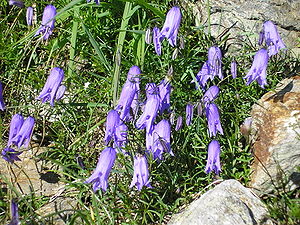Cut out bellflower
| Cut out bellflower | ||||||||||||
|---|---|---|---|---|---|---|---|---|---|---|---|---|

Cut out bellflower ( Campanula excisa ) |
||||||||||||
| Systematics | ||||||||||||
|
||||||||||||
| Scientific name | ||||||||||||
| Campanula excisa | ||||||||||||
| Creep. ex Murith |
The cut bellflower ( Campanula excisa ) is a species of the genus bellflower ( Campanula ) within the family of the bellflower family (Campanulaceae).
description
Vegetative characteristics
The cut bellflower is a perennial herbaceous plant that reaches heights of 5 to 12, rarely up to 20 centimeters. It grows in loose grass . The stem is simple, arching, and has short hairs in the lower area.
The leaves are basal and arranged alternately on the stem. The basal leaves are heart-shaped, stalked and mostly already dried up to the anthesis . The lower stem leaves are lanceolate and obtuse, the upper ones linear and pointed; the lower ones wider than the upper ones.
Generative characteristics
The flowering period extends from July to August. The often nodding flowers are usually found individually at the end of the stem. The bracts are shorter than the flower stalks.
The hermaphrodite flowers are five-fold with a double flower envelope . The bald, protruding calyx tips are almost linear and their bays are round, there are no appendages. The five light blue-violet petals are fused to almost half of their length to form a 10 to 25 millimeter long, narrow, bell-shaped crown and longer than their diameter. The corolla lobes are egg-shaped, their bays are rounded, this is only with this type of bellflower, from which the epithet excisa and the common name cut-out bellflower are derived.
The nodding fruit is glabrous and opens with three holes at its base.
The number of chromosomes is 2n = 34.
Occurrence
The cut bellflower is endemic to the western Alps from the Graian to the Ticino Alps . It is common locally. It grows on silicate in crevices, rubble and scree in the subalpine to alpine level at altitudes of 1800 to 2300 meters.
Taxonomy
The first description of Campanula excisa was made in 1810 by Johann Christoph Schleicher in Laurent-Joseph Murith : Le Guide du Botaniste qui voyage dans le Valais: avec un catalog des Plantes de ce pays et de ses environs, auquel on a joint les lieux de naissance et l époque de la fleuraison pour chaque espèce. Lausanne , page 57.
literature
- Xaver Finkenzeller, Jürke Grau: Alpine flowers (Steinbach's natural guide). Mosaik Verlag GmbH, Munich 1996, ISBN 3-576-10558-1 .
- Konrad Lauber, Gerhart Wagner: Flora Helvetica. Flora of Switzerland. Verlag Paul Haupt, Bern, Stuttgart, Vienna, 1996, ISBN 3-258-05405-3 , p. 986.
- Hans Ernst Hess, Elias Landolt, Rosmarie Hirzel: Plumbaginaceae - Compositae . In: Flora of Switzerland and adjacent areas . tape 3 . Springer, 2013, ISBN 978-3-0348-7655-1 ( Campanula excisa on page 389 in the Google book search).
Individual evidence
- ↑ a b c d e f g Campanula excisa Murith In: Info Flora , the national data and information center for Swiss flora . Retrieved October 2, 2018.
- ↑ a b c Hans Ernst Hess, Elias Landolt, Rosmarie Hirzel: Plumbaginaceae - Compositae . In: Flora of Switzerland and adjacent areas . tape 3 . Springer, 2013, ISBN 978-3-0348-7655-1 ( Campanula excisa on page 389 in the Google book search).
- ^ Konrad Lauber, Gerhart Wagner: Flora Helvetica. Flora of Switzerland. Verlag Paul Haupt, Bern, Stuttgart, Vienna, 1996, ISBN 3-258-05405-3 , p. 986.
